View Thirty One: Paul Morrison recalls 36 Years of Roseate Tern Management
My first involvement with Coquet Island was in the early 80’s when I helped Gordon Easton unload provisions for the keepers from his boat the ‘G Jennifer’. It wasn’t long before I was volunteering for the “blummin’ bird warden” as the keepers referred to him, who was living in a small two-roomed shed outside the heligarden wall.
There were several thousand pairs of puffins, some 500 pairs of black-headed gulls, several hundred common and Arctic terns and a mere 18 pairs of roseate terns, Britain’s rarest nesting seabird. At that time roseates were nesting in small numbers around the coast of the UK with colonies in Wales and Scotland but numbers were dwindling. Protection measures for roseates on Coquet were limited to restricting public access to the island (something that benefited all the nesting birds on Coquet) and controlling predation by large gulls.
Large gulls loafed in large numbers on the rocky intertidal area at the north end of the island but very few bred as they were controlled by poisoning at the nest with the use of alphachloralose and their eggs destroyed. The practice of poisoning continued until 1989 after which it was banned by Nature Conservancy Council (now Natural England) as it was considered inhumane. The collection of large gull eggs continued and "rogue" gulls (those identified as targeting tern chicks/ eggs) shot under licence.
The handful of roseates that nested used secluded rocky crevices or the edge of rank vegetation. A handful of wooden nest boxes along with car tyres were placed near the lighthouse in the hope of offering more opportunities for roseates to nest in (as was the case on reserves in the USA) but none took up the offer. It wasn’t until 2000, when I was given the chance to accompany a member of the Ghana Wildlife Society (Sami Adu) to visit the island of Rockabill in the Republic of Ireland, that everything changed!
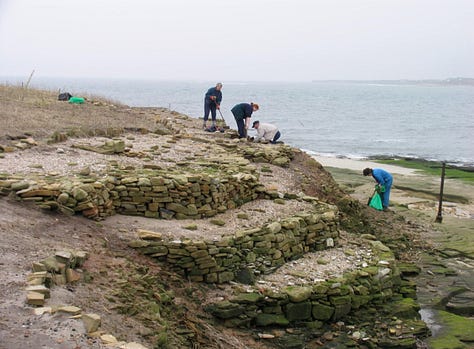
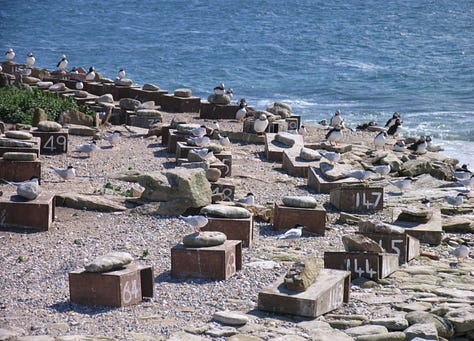
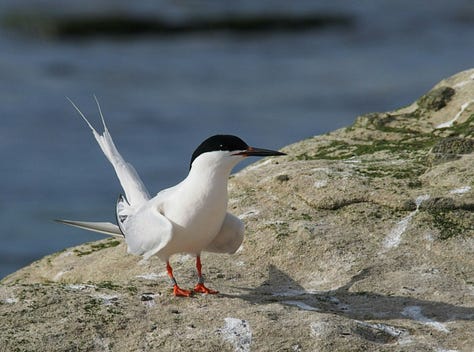

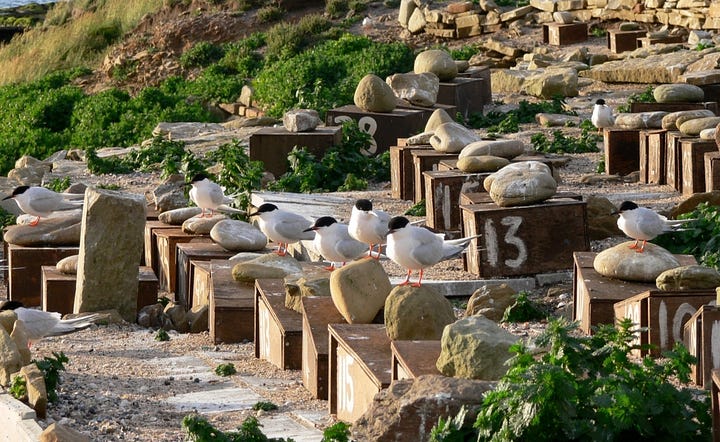
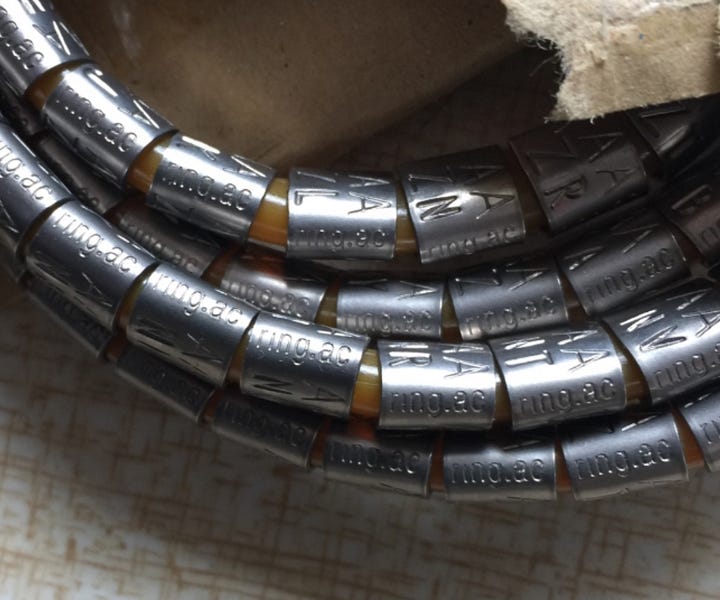
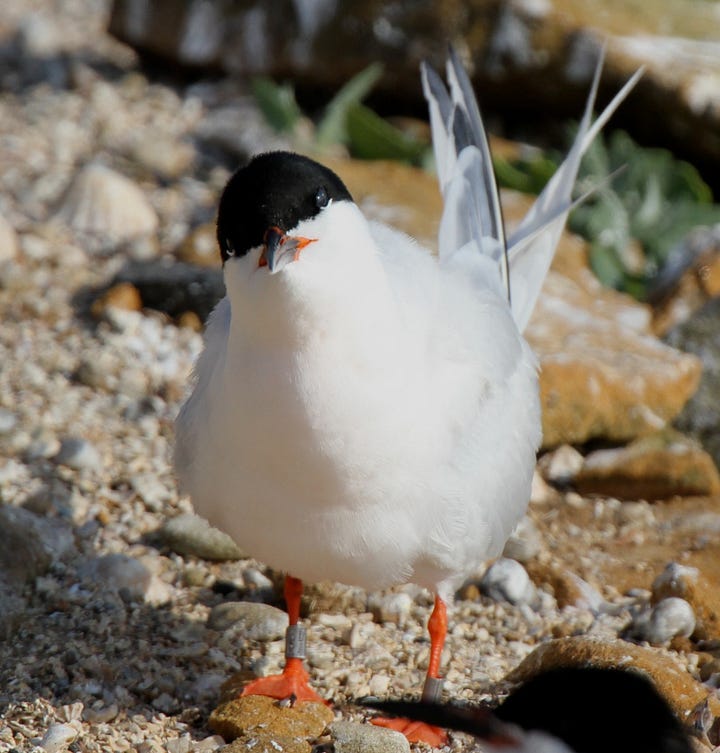
Roseates leave our shores at the end of July /early August with their fledglings and set off to the waters off the Ghanaian coast to over-winter before returning to Rockabill and Coquet (and a few to France) the following spring. Rockabill is the European stronghold for the species with over 1500 pairs nesting there. On Rockabill I was impressed with the hundreds of roseate nest boxes laid out on terraces of almost bare rock in tightly packed groups - and most of them were occupied! Common terns also nested around the roseates and the manager for the reserve enlightened me by explaining that roseates won’t nest unless there are common terns present. Roseates are rather timid terns and take advantage of the more aggressive behaviour of the commons by favouring nest sites near them. In so doing the roseates gain protection against predators such as encroaching large gulls as the commons fearlessly fend off the gulls with effective pecks and well-aimed guano!
I took these thoughts back to Coquet and after seeking permissions and with the help of volunteers embarked on creating the first roseate nesting terrace complete with 50 special wooden roseate tern nest boxes, made by local schoolchildren. That same season all the roseate terns took up the offer and the numbers of nesting pairs increased to 35 couples. I noticed some of the roseates were carefully selecting small pieces of shell shingle and flicking them into their boxes and using them to create nesting scrapes. Luckily, on Coquet there is a small shingle beach and from that year on, fresh shingle has been collected and spread on the terraces, ensuring a fresh nesting substrate was provided each year. The art of "shingling" was invented.
From that year on there has been an upward trend in the numbers of roseates each year which was matched with adding more terraces and boxes to accommodate them (and a few more). The winning combination of shingle covered terraces, purpose made nest boxes (now made from recycled plastic), encouraging common terns to nest nearby and reducing disturbance to a minimum and resulted in Coquet bucking the decline elsewhere in the country.
Coquet Island is now the sole nesting colony of roseates in the UK. The conservation management work on Coquet has been backed up with a detailed monitoring programme that ensured monitoring methods were carried out the same way from year to year which enabled researchers to accurately gauge the success trends of the colonies,both on Coquet and on Rockabill. Chicks have been ringed on both sites since the start of the nest box programme so we have a clear insight into the trends of this iconic species.
By 2022 the numbers of breeding roseates had reached a record 154 pairs but disaster struck. An outbreak of bird flu in 2022 hit the roseate terns hard and an estimated 50% of chicks succumbed to the disease and sadly in 2023, the return of the disease further reduced the roseate colony and interrupted the detailed monitoring programme. Terraces, shingle and boxes are still provided in the hope of recruiting birds from elsewhere or those that have survived and developed immunity. Hopefully with the right management and dedication the success story of roseate terns will continue.
View Thirty Two: Mark Callan and his poem Grey Cloud
Mark’s poem was inspired by this project and classical Chinese poetry.
Grey cloud rain obscures Sun glint on water blinds How then see Coquet Island?
View Thirty Three: Luke McTaggart and Moon Over Coquet Island (Study)
Luke writes: As soon as Allan raised the idea of this project I was struck by a vivid memory of a very particular view of Coquet Island. Whilst at university I would come home to paint in the fields at weekends. In 2019, in the depths of winter, I came back into Alnmouth station in the dark. Travelling home to Amble in the car I recall seeing a bright full moon high in the sky over the sea. Coquet Island sat there, a thin, dark sliver on the horizon, adrift in the column of moonlight cast across the sea. The water had a very particular quicksilver-like quality, broken at the bottom by the waves breaking on Birling Carrs.
This angle interests me as, much like the view from beyond Bilton, the island looks slightly different. There is an altered sense of scale as, rather than sitting on the horizon, the island has a strip of sea behind it. I’ve tried to recapture the view in this watercolour, conjured from memory.
You can see more of Luke’s work on his website here.
View Thirty Four: Steven Banks and a Short History of Puffin Cruises
For decades, Puffin Cruises has been taking visitors out to see the wildlife around Coquet Island. It was established in 1969 by my Grandfather Dave Gray when he began taking trips out in the summer months bringing people to the puffins.
The very first boat trips were 1s 3d or 2s 6d in old money for a trip in his boat 'G Fisher'. Dave's first introduction to Coquet Island was when he went there as a child with his father to visit the lighthouse keepers in the late 1930’s. One of the fascinating stories I can recall my grandfather telling me was about the day one of the keepers saw the first ever puffin appear on Coquet Island, which has since blossomed into a strong colony of puffins.
There was also the period of 'Freddie the Dolphin' in the 80’s which my grandfather said put Amble on the map, when trips were available to see and swim with this Bottlenose Dolphin who took residence in the waters off Amble for a number of years.
Puffin Cruises has a number of duties on the island: one is to maintain Coquet Lighthouse on behalf of Trinity House, the lighthouse authority. We head over on monthly visits to carry out maintenance, ensuring the lighthouse still operates as an important aid to navigation. We also provide a boat service for the RSPB, who manage the island, by taking heavy equipment and supplies across as well as ferrying the wardens between the island and mainland.
Coquet Island is a hidden gem of Northumberland and on our boat trips we enjoy telling the island's history, including St Cuthbert, the monks who took sanctuary on the island, the lighthouse’s unique castellation design, and of course the fantastic wildlife.
This season we have made some changes to our operation with a new booking office and gift shop now open in Amble Harbour Village where we have a live feed from the island showing the RSPB 'Puffin Cam'. We have a new passenger boat operating this season, with a whole new booking system to make the experience of Coquet Island feel even more special.
Steven Banks and David Gray (Dave’s son) run the operation and you can find out more here.
View Thirty Five: Anthony Wright and his photo Towards Coquet Island
Tony is a member of Amble Photographic Group and you can find more of his work here.
View Thirty Six: Isabel Morrison and Madelaine Leddy with Coquet Island Lilt
Isabel writes: One evening, 35 years ago, I had the wonderful privilege of sitting on the jetty on Coquet Island, watching the sun setting over the Northumberland coast. I was thus inspired to write the “Coquet Island Lilt”. The song featured on BBC Look North at the time. This recording features talented local singer, Madelaine Leddy.
Isabel can be found on Facebook here. Maddy is a member of the Wild Cloudberries, whose Facebook page is here.
Lyrics
I sit by the sands of my dear Coquet Island The waves lap the shore by my feet Above me in thousands the birds are all circling The sound of their song is so sweet Ho do ro do ro Ho do ree Their song is borne of the sea Ho do ro do ro Ho do ree The spell of this island for me I watch as the sun sets behind Amble harbour The castles and hills fade away The darkening form of Northumberland's coastline A perfect goodbye to the day Ho do ro....How tranquil here by the sea etc Now darkness has fallen upon Coquet Island The lighthouse shines forth red and white The foghorn is sounding for miles through the mist Giving warning to ships in the night Ho do ro...The light shines over the sea etc Tomorrow I know I must leave Coquet Island Tonight I shall sit by the shore And dream of the day I'll return to this island My heart will be here ever more Ho do ro...The birds sing over the sea etc
Thanks to all the wonderfully creative people who have contributed a view of Coquet Island, which now feels full of ‘Sounds and sweet airs that give delight’. We hope to exhibit and perform these views in the future and I’ll keep you updated when and where that happens.
Meanwhile, I’m going to continue publishing a piece of writing here each week - mainly reflective non-fiction - and I hope you’ll join me.




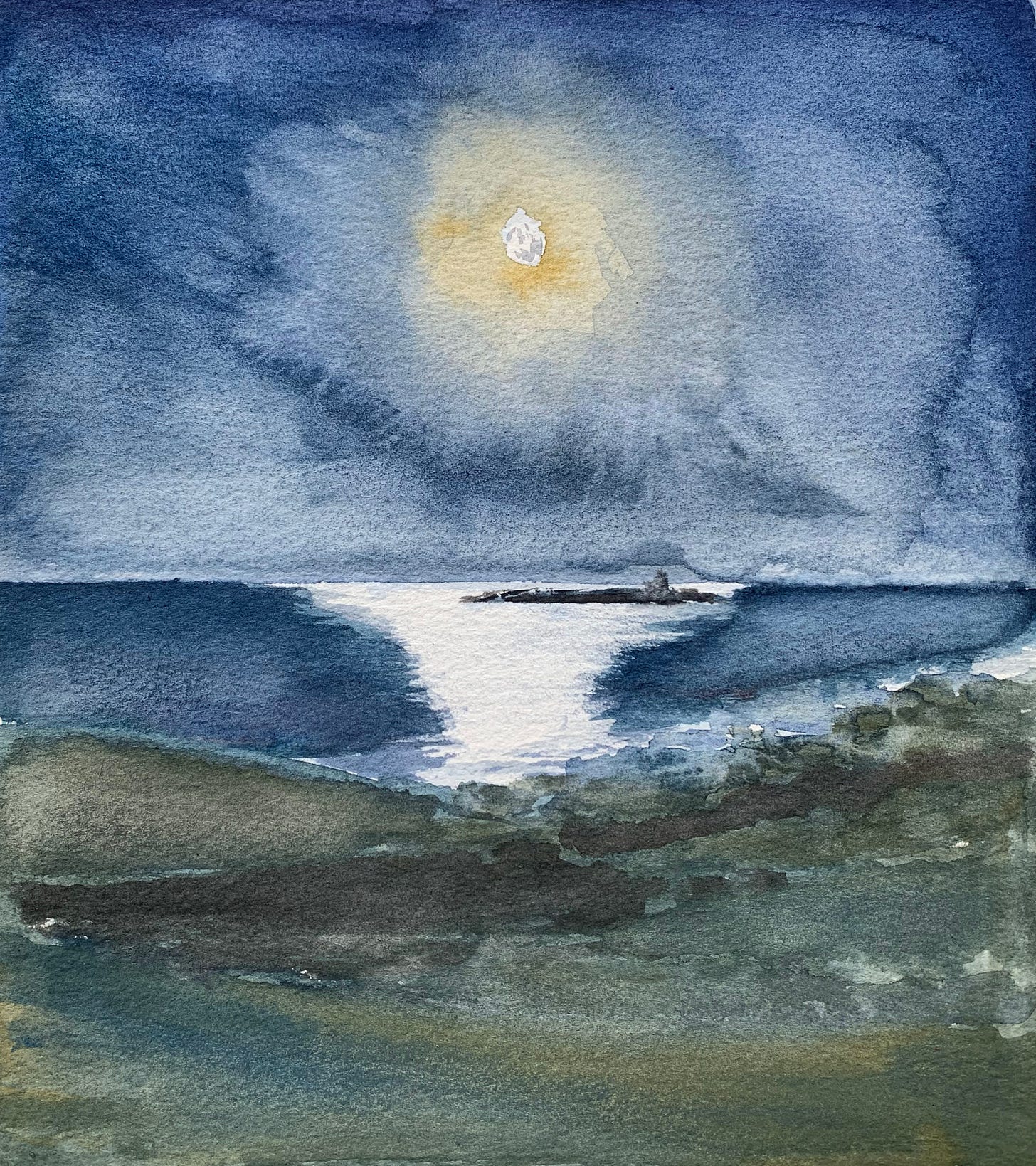
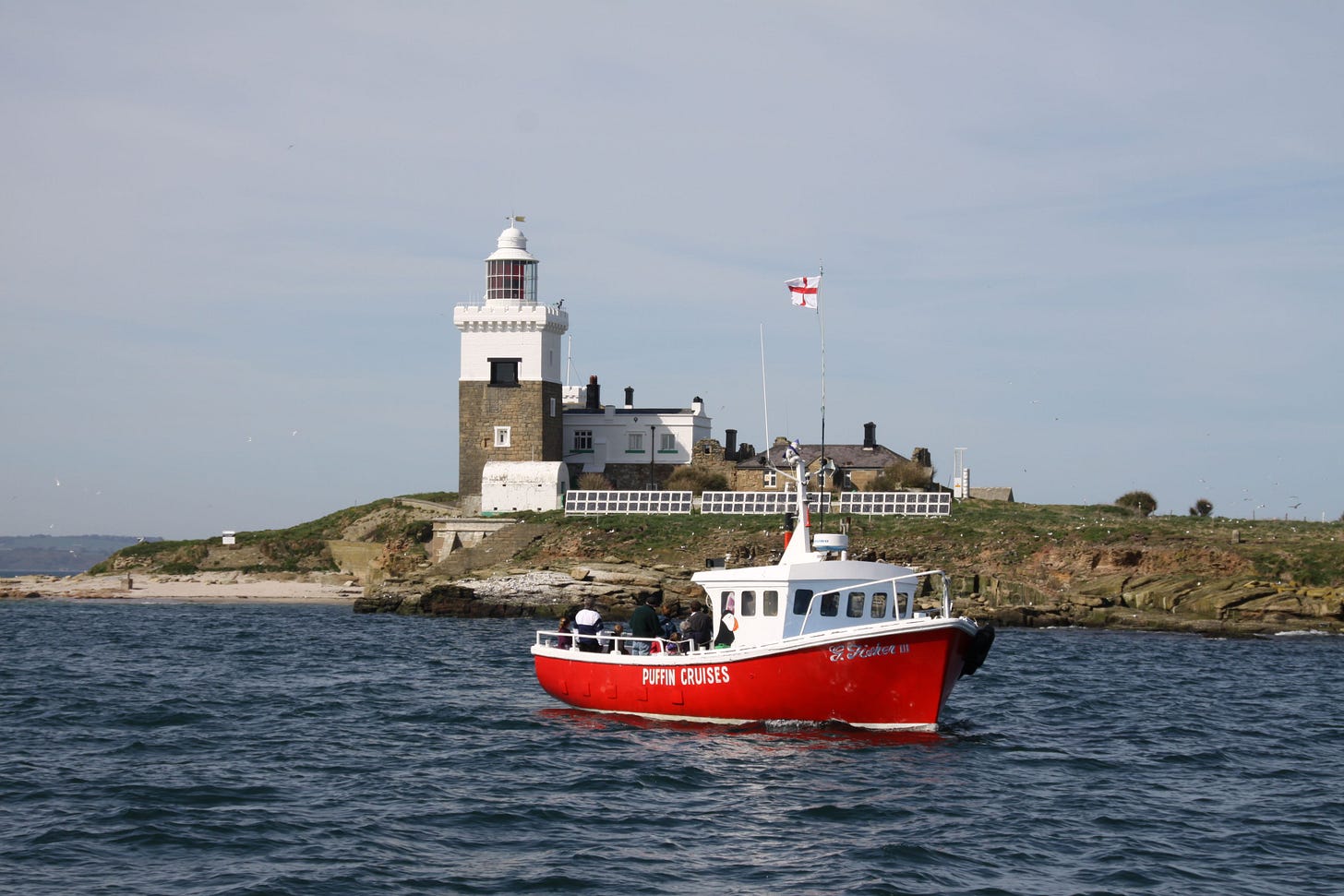

What a great project this has been. Where are you going next?
My pleasure!